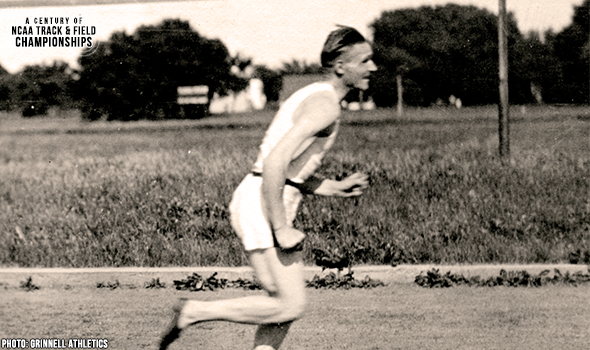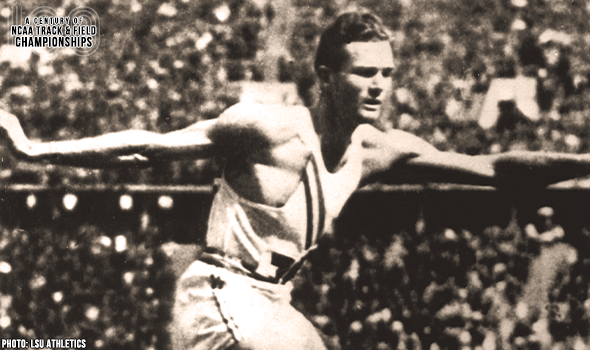
Lindgren Had No Peer In NCAA
Before Gerry Lindgren ever ran for Washington State varsity, he had set a world record, competed in the Olympics and left more than 50,000 fans roaring him to victory – all as a teenager.
Lindgren followed that with a Cougar career that made him the winningest NCAA athlete with 11 combined NCAA titles between cross country, indoor track & field and outdoor track & field. Today, he ranks No. 3 on that list and the two ahead of him (Edward Cheserek of Oregon and Suleiman Nyambui of UTEP) had four years of eligibility, while Lindgren only had three.
Collegiately, Lindgren had no peer in any sport. His six victories at the NCAA Outdoor Track & Field Championships – three straight doubles between 1966 and 1968 comprised of the 3-mile/5000 and 6-mile/10,000 – were by an average margin of more than 10 seconds. Indoors, he lost just once – to Jim Ryun in the 2-mile, relatively short for the long-distance wizard that was Lindgren. In cross country, he had one career loss, to a freshman from Oregon named Steve Prefontaine; he avenged it twice.
His dominance was nothing new.
Track & Field News called Lindgren “the 18-year-old baby of the team” in its report of the 1964 U.S. dual meet against the Soviet Union, held in front of more than 50,000 spectators in the Los Angeles Memorial Coliseum. “He stole the hearts of the sun-drenched spectators.” He won by over a homestretch in just his second attempt at the 10K distance.
The prodigy from Spokane, Washington, was finally able to attend Washington State in the spring of 1965, but rules then did not allow freshmen to compete in the NCAA. His biggest race that year came against Billy Mills – his gold-medal winning teammate at the 1964 Tokyo Olympics – as both set the same world record of 27:11.6 in a thrilling 6-mile race at the AAU national championships (Mills was first to cross the finish line at Balboa Stadium).
The NCAA and collegiate track & field will mark a momentous milestone in the spring of 2021 -- the 100th anniversary of the NCAA Championships and with that, the NCAA Track & Field Championships. In June 1921, the University of Chicago hosted the first track & field championships in NCAA history.
This point can’t be emphasized enough: Not only was the event the first for NCAA track & field, but the first championships for any sport under the sponsorship of the NCAA.
To celebrate, over each of the next 365 days, the U.S. Track & Field and Cross Country Coaches Association (USTFCCCA) will celebrate moments, student-athletes, and coaches that have made a century’s worth of championships special. From humble beginnings to important historical milestones to the modern-day, collegiate track & field has evolved with the American society.
The 2021 edition of the NCAA Division I Outdoor Track & Field Championships begin with preliminary round action on May 27-29 in Jacksonville, Fla., and College Station, Texas. The championships final site and culmination of the celebration is slated for June 9-12, 2021 at the newly rebuilt Hayward Field in Eugene, Ore.

SIU’s Roggy Dominated The Javelin In 1978
Bob Roggy won the javelin title at the 1978 NCAA DI Outdoor T&F Championships by more than 20 feet. Roggy qualified first for the final with a MR heave of 89.30m (293‑0).

Makusha Made History In Bowerman Year Of 2011
Ngoni Makusha became just the fourth man in meet history to win individual titles in both the 100 and LJ. It was his 3rd career LJ crown and he set a CR in the 100 of 9.89.

George Mason’s Gage Shocked The NCAA LJ In 1988
Nena Gage won the long jump at the 1988 NCAA DI Outdoor T&F Championships in a shocking upset over Gail Devers.

Texas’ Thompson Marveled In NCAA Distance Events
Jerry Thompson won three career distance titles at the NCAA Outdoor T&F Championships. His first came in 1943. Then he won again in 1947 & 1948 after serving in World War II.

Grinnell’s Paulu Sprinted To NCAA History
Leonard Paulu was the first athlete to complete the 100-200 double in NCAA Outdoor Track & Field Championships history in 1922. That also made him the 1st to win back-to-back 100 titles, too.

Scott Won Back-To-Back NCAA Hammer Titles
Candice Scott won back-to-back hammer throw titles at the NCAA DI Outdoor T&F Championships in 2003 & 2004. Scott set a meet record of 69.77m (228-11) in that first year.

Drouin Soared To The Bowerman In 2013
Derek Drouin won two career HJ titles at the NCAA DI Outdoor T&F Championships. When Drouin won in 2013, he was only the fourth man to clear 2.34m (7-8) in meet history.

Watts Made Quick Work Of NCAA 400
Quincy Watts set a meet record in the 400 of 44.00 at the 1992 NCAA DI Outdoor Track & Field Championships. It lasted 25 years until 2017.

Iowa State’s Koll Rolled To 5K-10K Crowns
Lisa Koll won three career titles at the NCAA DI Outdoor T&F Championships in dominant fashion. Her average margin of victory in those 5K & 10K races was 37.73 seconds.

LSU’s Hardin Completed Unique 440-220H Double Twice
The nearly unheard of 440-220H double was so nice that Glenn Hardin did it twice! Hardin became the first to do so in meet history in 1933 and then swept them again in 1934.

